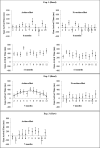The impact of salient action effects on 6-, 7-, and 11-month-olds' goal-predictive gaze shifts for a human grasping action
- PMID: 33007025
- PMCID: PMC7531859
- DOI: 10.1371/journal.pone.0240165
The impact of salient action effects on 6-, 7-, and 11-month-olds' goal-predictive gaze shifts for a human grasping action
Abstract
When infants observe a human grasping action, experience-based accounts predict that all infants familiar with grasping actions should be able to predict the goal regardless of additional agency cues such as an action effect. Cue-based accounts, however, suggest that infants use agency cues to identify and predict action goals when the action or the agent is not familiar. From these accounts, we hypothesized that younger infants would need additional agency cues such as a salient action effect to predict the goal of a human grasping action, whereas older infants should be able to predict the goal regardless of agency cues. In three experiments, we presented 6-, 7-, and 11-month-olds with videos of a manual grasping action presented either with or without an additional salient action effect (Exp. 1 and 2), or we presented 7-month-olds with videos of a mechanical claw performing a grasping action presented with a salient action effect (Exp. 3). The 6-month-olds showed tracking gaze behavior, and the 11-month-olds showed predictive gaze behavior, regardless of the action effect. However, the 7-month-olds showed predictive gaze behavior in the action-effect condition, but tracking gaze behavior in the no-action-effect condition and in the action-effect condition with a mechanical claw. The results therefore support the idea that salient action effects are especially important for infants' goal predictions from 7 months on, and that this facilitating influence of action effects is selective for the observation of human hands.
Conflict of interest statement
The authors have declared that no competing interests exist.
Figures



References
Publication types
MeSH terms
LinkOut - more resources
Full Text Sources

